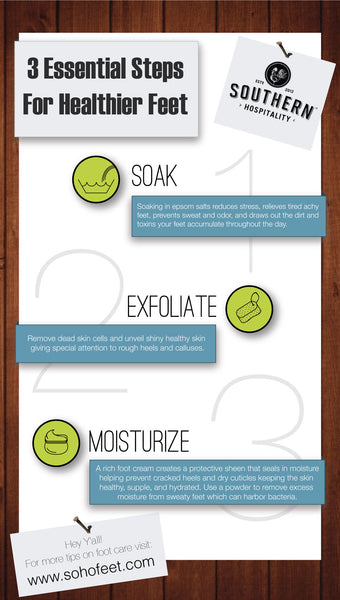Nail Salons? You Better Think Twice!
We here at Southern Hospitality recommend that you take a personal natural approach to show your puppies some love. Check out this video from ABC’s 20/20 and see why putting your feet in the wrong hands can spell danger for your dogs! Well, guess what they say is true.......if you want something done right, you just may have to do it yourself!
Putting you best FEET forward,
SH
Hair It Is!

FOOT FACT:
Hair on top of your feet and (dare I say) toes is actually a good thing. That’s right!...it indicates good blood flow to your legs and feet. An absence or loss of hair on those “10 lil piggies” could be a sign of poor circulation. Blood carries nutrients to your hair follicles allowing them to grow and flourish. Lack of blood flow means lack of hair. In other words, the heart loses the ability to pump enough blood to you feet due to blocked arteries. Diabetics, smokers, and those with a history of heart conditions should especially take note!
Putting your best FEET forward,
SH
NO SWEAT! (PART 2): 4 MORE REMEDIES YOU CAN USE TO FIGHT SWEATY FEET

Sweaty feet STILL got you in a funk?
Here are 4 MORE remedies you can use to fight sweaty feet.
1. Hair today, gone tomorrow! Hair harbors more bacteria than your skin. Removal of the excess hair from your feet helps minimize odor, while causing a drop in sweat production. Chop-chop!
2. Replace insoles every 2-3 months. While insoles contribute to a comfortable fitting shoe, they also absorb much of the excess perspiration from your feet. Over time, your insoles become quite saturated and develop a not-so-pleasant aroma.
3. Put a sock ON it! Cotton socks are a known help for soaking up the sweat. But did you know that merino wool is another fabric to consider? This material is common in athletic wear and is praised for its ability to absorb sweat without feeling wet.
May we also suggest…
4. Botox. Yes, you read right! This anti-aging technique not only work wonders on crow’s feet but can do a number on YOUR feet. The botox is administered via a series of injections where the nerves become paralyzed, stifling excess feet sweating. The price for the procedure can be a bit steep (in the neighborhood of $1000+) AND the effects are only temporary- lasting 6 months to a year.
Don’t forget to LIKE US on facebook!!
Putting your best FEET forward,
SH
NO SWEAT! (PART 1) : 7 REMEDIES YOU CAN USE TO FIGHT SWEATY FEET

What does the number 250,000 and your feet have in common?
(Cue the theme from jeopardy)……Oh, times up!
That’s the total number of sweat glands found in your feet. On average, these glands can excrete up to half a pint of sweat per day. But for some of us, this quantity may only be a drop in the bucket. Sweating is a normal function to cool the body, but with excess sweat- known as hyperhydrosis- comes a breeding ground for bacteria, fungus, and the dreaded stench from smelly feet. Combine other factors such as high physical activity and a warm climate and sweaty feet can REALLY get out of hand (ha!).
Here are 7 remedies you can use to fight sweaty feet.
1. Wearing cotton socks with close-toed shoes is a MUST! Socks act as a barrier to soak up the sweat. Bare feet + sweat + shoes= a STINKY situation! Avoid dark colors (navy blue, black) due to their ability to retain heat. Replace socks AT LEAST once daily. Socks can become saturated with sweat and cause more harm than good (i.e. blisters).
2. Swap shoes. NEVER wear the same shoes in consecutive days. Allow your shoes to air out at least 24 hours each time after they are worn.
3. Dust feet with foot powder. The soles of the feet, between the toes, and inside the shoes are the areas of concern.
4. Soaking your feet in a basin of warm water and Epsom salt deodorizes and draws out toxins that your feet encounter during the day. Repeat this 3 to 4 times per week.
5. Make sure your feet are completely dry AFTER bathing. Pay special attention in between the toes. Moist, warm environments that are tight and enclosed are a recipe for disaster against keeping your feet clean and dry.
6. Watch your diet. That’s right…. spicy food, alcohol, and drinks with caffeine (coffee, tea, sodas) can promote increased sweating.
7. Spray the insides of your shoes with Lysol to eliminate bacteria. We all know sweaty feet that reek go hand-in-hand. Use this as a one, two punch with the other remedies mentioned.
What has been your experience? Any other remedies you’ve found to be a “go-to” for sweaty feet?
Putting your best FEET forward,
SH
Infographic Series - 3 Steps to Healthier Feet
Last month we talked about the steps to healthier feet. Here's a cute visual and easy way to remember in 3 steps! Just click on the infographic for a larger view. We'll be posting more of these in the coming weeks so make sure to follow us on Twitter!
It’s Easy as 1, 2, 3:Essential Vitamins for Fit, Healthy Feet (Part 2)

…and now back to class. It’s time to learn the rest of your ABC’s of healthy feet!
Vitamin D[Ergocalciferol(vitamin D2),Cholecalciferol (vitamin D3)]
Benefits: Calcium gets most of the credit for the development of strong healthy bones, but it’s vitamin D- specifically D3- that allows our bodies to absorb and utilize calcium. In terms of the feet, stress fractures and overuse injuries can be minimized with this vitamin in our dietary arsenal.
Source: Sunlight, fortified dairy products, eggs, salmon, mackerel, vitamin supplement
Attention: Athletes, runners, dancers, children, postmenopausal women, elderly, diabetics
Oh by the way: Wearing sunscreen can prevent absorption of vitamin D from sunlight. However, going without sunscreen can be damaging to the skin against the sun’s harmful rays (Skin cancer…I think NOT). Therefore, a sound diet may be the best approach to receive your supply of vitamin D. Fat-soluble.
Vitamin E (alpha-tocopherol)
Benefits: Gimme an E! This wonderful nutrient functions to do away with those pesky free radicals. Together with vitamins A & C, your feet maintain healthy skin, preventing invasion of fungus, viruses, and bacteria!
Source: Almonds, leafy green vegetables, olive oil, sweet potatoes, sunflower seeds, vitamin supplement
Attention: Diabetics, beach-goers
Oh by the way: Studies have shown that vitamin E contributes to fighting heart disease and plaque formation in arteries, although results are not conclusive. Fat-soluble.
Vitamin K (Phytonadione)
Benefits: Known for blood clot formation, vitamin K fights excessive bleeding from punctures and other open wounds. Walking barefoot?...Think twice!... Shoeless feet are highly prone to stepping on foreign objects- rocks, glass, nails, and twigs, among others. Vitamin K is also capable of strengthening bones.
Source: Spinach, turnip greens, cabbage, broccoli, kale
Attention: Burn victims, diabetics, beach-goers, athletes, postmenopausal women
Oh by the way: People- with a history of heart disease or peripheral vascular disease (PVD) - who take blood thinners (such as Coumadin [Warfarin] or even aspirin) may be advised by their physician to minimize their intake of vitamin K, to prevent formation of blood clots in the bloodstream. Fat-soluble.
Putting your best FEET forward,
SH
It’s Easy as 1, 2, 3:Essential Vitamins for Fit, Healthy Feet (Part 1)

Who can forget learning their ABC’s as a kid? From A to Z, we utilize the building blocks of communication that allow us to speak, read, and write. But allow us to introduce you to a new set of ABC’s……the ABC’s of healthy feet!
Vitamin A (Retinol, Retinoid)
Benefits: Known to develop keen eyesight and smoothing under eye wrinkles, vitamin A works wonders to keep the rough areas of the feet silky smooth. Acting as a safeguard during the winter months- against cracked heels- and a protector of sun damaged feet during the summer months (yikes!), vitamin A is an absolute must-have to revive tissues, scrapes, lesions, and wounds of the feet.
Source: Carrots, liver, paprika, sweet potatoes, leafy green vegetables, topical lotions/creams
Attention: Diabetics, beach-goers, people with psoriasis
Oh by the way: Vitamin A is classified as fat-soluble, meaning: 1) it travels from the fat, 2) into the bloodstream (to be used by the body) 3) and the excess IS stored in the liver; daily supply is NOT required in diet.
Vitamin B12 (Cobalamin, Cyanocobalamin)
Benefits: Numbness, burning, and tingling of the feet BEGONE with this B vitamin. Found to develop and maintain nerve conduction, vitamin B12 is essential from head-to-toe. A healthy nervous system enables our feet to maintain balance and sensation (for touching). Listen up diabetics!!......this vitamin is for you!
Source: Clams, fortified cereals/whole grains, milk, eggs, poultry, vitamin supplement or injection
Attention: Vegans, vegetarians, diabetics, the elderly, people with gastrointestinal surgery
Oh by the way: Nutrient is not found in plants NATURALLY- plants can be fortified with the nutrient, however; daily recommended amounts can be received via vitamin supplement. Classified as water-soluble, vitamin B12 dissolves directly in the bloodstream and is NOT stored in the body; excess is eliminated in the urine; a continuous daily supply IS needed in our diet.
Vitamin C (Ascorbic acid)
Benefits: Free-radicals don’t stand a chance against vitamin C. As a notable antioxidant, vitamin C plays a key role in the production of collagen, helping to keep the skin firm and strong. Hangnails and ingrown toenails?……..That’s ok! Vitamin C has got you covered.
Source: Oranges, spinach, brussels sprouts, green pepper, grapefruit, topical lotion/creams
Attention: Diabetics, beach-goers
Oh by the way: May alleviate the effects of sun damaged skin- sun spots and hyperpigmentation to name a few. Water-soluble.
** Don't go too far...Come on back for Part 2!!!!!!!!!!! **
Don’t forget to LIKE US on facebook AND follow us on twitter!
Putting your best FEET forward,
SH
SKIN-CREDIBLE: KNOW YOUR SKIN INSIDE AND OUT

Loving the skin you’re in means knowing how the body’s largest organ functions. Knowledge of how your skin functions gives you appreciation of how your skin takes care of you, so you can take care of it.
In this post, you will discover the 3 layers of the skin and their roles to keep you covered.
Epidermis- The Protector 
Serving as your body’s first line of defense, the epidermis is a safeguard against harmful microorganisms and your environment. Keratin- makes up 95% of the protective layer- works to seal in moisture, to maintain your skin’s hydration. Melanin- which contributes to your skin tone- is produced to shield the skin against the sun’s harsh UV rays.
Foot fact:Constant rubbing and friction can contribute to excess keratin formation- better known to the world as corns and calluses- that affects the epidermis. Ill-fitting shoes , walking barefoot, and prolonged walking/running are the common causes.
Dermis- The Provider 
Ever wondered where sweat comes from, or how is it that you are able to touch, and feel changes in temperature? Look no further than the dermis. This middle layer has sweat glands galore- to regulate body temperature- and loaded with nerve endings- to provide sensation. Collagen is a prime protein that maintains skin structure and strength, while blood vessels supply your skin with nutrients.
Foot fact:The dermis is the primary location for hair follicles. However parts of the body, such as the soles of the feet, lack these structures.
Hypodermis- The Foundation 
What’s in a name? Well,…everything! Hypodermis literally means: below (hypo) skin (derm). As the deepest layer, the hypodermis fastens the skin to the underlying structures (bones, organs, muscles, etc.) in the body. It is primarily composed of fat- aka adipose tissue- that provides much needed insulation and a layer of shock absorption from impact. Who knew fat could be a good thing?!
Foot fact:Fat pads at the heels and balls of the feet serve as protective padding for internal structures when walking/running. Those fat pads can diminish- in a condition known as fat pad atrophy- that can result in painful steps when walking (esp. barefoot). To manage, wear soft, cushioned insoles. Athletes and the elderly are most at risk.
Putting your best FEET forward,
SH






